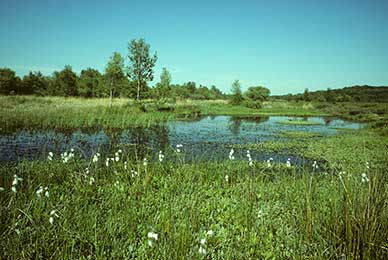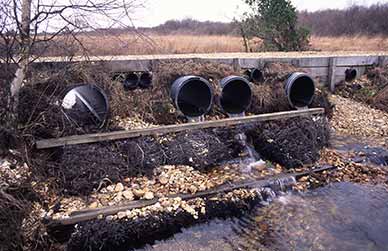Valley mires and other wetlands

Rowbarrow Pond
A call for those with an interest in New Forest bogs, valley mires and seepage-step mires, to identify themselves would probably receive little response.
Yet these wet, seemingly uninviting expanses of swaying cottongrass and squelchy sphagnum moss are marvellously important though greatly under-rated places where can be found a wide range of wildlife that elsewhere in lowland Britain has significantly declined following widespread drainage and development schemes.
Here in the New Forest, though, these wide, shallow valley-bottom wetlands are both nationally and internationally important. The 90 examples in the New Forest account for around 80% of all those in lowland England, and a large percentage, too, of those in western Europe.
Indeed, there is more of this type of habitat in the New Forest than in the remainder of Britain and western Europe put together, so-much-so that all were designated Wetlands of International Importance under the 1993 Ramsar Convention.
In these places, the spring and early-summer months are enlivened by the haunting sounds of breeding curlews, snipe, lapwings and occasional redshanks; whilst from April to October, myriad colourful dragonflies and damselflies are likely to be on the wing, insects that spend their early life in the depths of the bog pools.
Rare black bog ants, too, are present. Found elsewhere in Britain only on the Dorset heaths and at a single South Wales site, their distinctive conical-shaped nests sometimes hold up 1,000 ants.
Plant-life is also widespread and diverse. Researchers found almost 90 species in one mire alone, whilst notable examples include the nationally rare bog orchid, the equally rare slender cottongrass, bog myrtle, bogbean, bog asphodel and the insectivorous sundews and butterworts.
But many New Forest bogs and valley mires are drier now than in days gone-by, although commoners’ stock - ponies, cattle and donkeys - occasionally get stuck, and even less frequently, walkers sink to waist or chest height and require helicopter rescue.
But gone are the times when ‘men, horses and carts were swallowed up’, as one late 19th century writer noted was then the case. Indeed, John Wise in the mid-19th century recounted a widespread belief in a ‘tricksy fairy’, a mischievous creature that inhabited these bogs, drawing people into them, and then laughing at their misfortune.
Relatively small scale drainage, undertaken for generations, gathered pace in the second half of the 19th century, and more significantly so following the New Forest Act of 1949 which contained provisions designed to increase and maintain grazing for the commoners’ stock. In fact, since then, around half these mires have shrunk in size and depth.
Even some of the drainage channels cut in the forestry inclosures, a common practice from the second half of the 19th century, have acted to reduce the water table in the surrounding floodplain, detrimentally affecting the condition of the mires.
Repair and restoration of these inclosure drainage channels is now, though, proposed; whilst the Forestry Commission, English Nature, RSPB, Hampshire Wildlife Trust and others have in recent years been engaged in a wider programme of wetland works.

deep out-flow channels were replaced by pipes
Part-funded by the European Union under the auspices of New Forest LIFE 2, this latter programme started in 1997 and was completed in 2001. Works included efforts to slow the flow of water out of the mires, forcing it to back-up, deepen and spread laterally across formerly occupied areas. Small dams made of planks, willow brushwood or heather were installed across outflow ditches, whilst in the most important wetland areas, deep out-flow channels were replaced by a series of pipes that now ensure slow, steady seepage, rather than a rushing torrent.
However, despite this activity, the follow-up project, Sustainable Wetland Restoration in the New Forest - LIFE 3, included in 2004 a survey of breeding waders, and found that since 1994 redshank, snipe and curlew numbers declined by 22-26%, 29% and 25%, respectively, whilst lapwings increased by 34-39%.
Researchers concluded that the losses were caused by recreational disturbance and / or changes in habitat quality.
Car park closures in sensitive areas and better warning signage, it is hoped, will reduce disturbance levels, but whether sufficiently to make a difference is not yet known. It also remains to be seen whether habitat improvement initiatives will have a significant impact.
References:
The New Forest: Its History and Scenery: John R. Wise.
The New Forest – A Natural History: Colin R. Tubbs
Hampshire Bird Reports: Hampshire Ornithological Society
ARKive: Black bog ant
More links
Other related links
Search this site

Sadly, 58 animals were killed - 35 ponies, 13 cows, 8 donkeys and 2 sheep, whilst a further 32 were injured - 3 pigs, 9 donkeys, 11 cows and 9 ponies.
(Forty-three accidents occurred in daylight, 15 at twilight and 101 in the dark. Twenty-seven accidents were not reported by the driver involved).
Here's just one horrific example - Three donkeys killed in collision with van at notorious New Forest blackspot (Advertiser and Times)
Sika deer continue to engage in rutting behaviour, and will do so until December.
Pigs seek out the remains of the acorn crop.
Beech leaves are transformed into a magnificent mosaic of glorious reds and golds. Other deciduous trees, too, take on an autumnal cloak before their leaves fall.
Dragonflies can occasionally be seen on the wing on bright days early in the month.
December
Foxglove leaves survive the winter at ground level, and offer the prospect of colourful summer blooms to come.
Redwings and fieldfares, autumn and winter visitors, gorge on haws and holly berries.
Great grey shrikes and hen harriers hunt over the heaths and other open spaces.
Honeysuckle by the end of the month often shows welcome signs of new growth.

